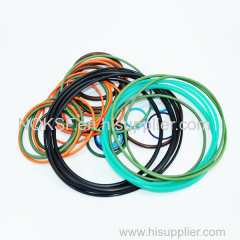
Rubber O Ring NBR FKM VMQ EPDM High Quality O-Ring Seal Suppliers
| Min. Order: | 500 Piece/Pieces |
|---|---|
| Trade Term: | EXW |
| Payment Terms: | Paypal, L/C, D/P, D/A, T/T, WU, Money Gram |
| Supply Ability: | 10000000 |
| Place of Origin: | Hebei |
Company Profile
| Location: | Xingtai, Hebei, China (Mainland) |
|---|---|
| Business Type: | Manufacturer |
Product Detail
| Means of Transport: | Ocean, Air, Land |
|---|---|
| Standard or Nonstandard: | Standard |
| Style: | O Ring |
| Material: | Rubber |
| Brand Name: | nqksf |
| Production Capacity: | 10000000 |
| Packing: | 10 pcs/ 1 paper scroll |
| Delivery Date: | 7-15 |
Product Description
O rings are essential components in various mechanical systems, providing reliable sealing solutions. The choice of material for O-rings significantly impacts their performance, durability, and suitability for different applications. This article explores the advantages and disadvantages of various O-ring materials and their specific uses.
1. Nitrile Rubber (NBR)
Advantages:
. Oil Resistance: NBR is highly resistant to petroleum-based oils and fuels, making it ideal for automotive and industrial applications.
. Cost-Effective: It is one of the most economical materials available.
. Good Mechanical Properties: NBR offers excellent tensile strength and abrasion resistance.
Disadvantages:
. Temperature Limitations: NBR is not suitable for high-temperature applications, with a typical operating range of -40°C to 125°C.
. Chemical Resistance: It has limited resistance to ozone, sunlight, and weathering.
. Applications: NBR is widely used in fuel systems, hydraulic systems, and oil seals due to its excellent oil resistance and affordability.
2. Fluoroelastomer (FKM)
Advantages:
. High-Temperature Resistance: FKM can withstand temperatures up to 250°C.
. Chemical Resistance: It is resistant to a wide range of chemicals, including acids, fuels, and solvents.
. Durability: FKM offers excellent aging and weathering properties.
Disadvantages:
. Cost: FKM is more expensive compared to other elastomers.
. Low-Temperature Performance: It becomes brittle at temperatures below -20°C.
Applications: FKM is commonly used in aerospace, automotive, and chemical processing industries where high temperature and chemical resistance are crucial.
3. Silicone Rubber (VMQ)
Advantages:
. Temperature Range: Silicone rubber can operate in a wide temperature range from -60°C to 225°C.
. Flexibility: It remains flexible at low temperatures.
. Biocompatibility: Silicone is non-toxic and suitable for medical applications.
Disadvantages:
. Tear Strength: It has lower tear strength compared to other elastomers.
. Chemical Resistance: Limited resistance to oils and fuels.
Applications: Silicone rubber is used in medical devices, food processing, and applications requiring high flexibility and biocompatibility.
4. Ethylene Propylene Diene Monomer (EPDM)
Advantages:
. Weather Resistance: EPDM is highly resistant to ozone, UV radiation, and weathering.
. Chemical Resistance: It is resistant to a wide range of chemicals, including acids and alkalis.
. Temperature Range: Operates effectively from -40°C to 125°C.
Disadvantages:
. Oil Resistance: EPDM is not suitable for applications involving petroleum-based oils and fuels.
. Compression Set: It has a higher compression set compared to other materials.
. Applications: EPDM is used in automotive cooling systems, water and steam applications, and outdoor environments due to its excellent weather resistance.
Choosing the right O-ring material involves balancing the specific requirements of the application with the material's properties. By understanding the advantages and disadvantages of each material, you can make informed decisions that enhance the performance and longevity of your systems. Next time you select an O-ring, consider the unique demands of your application and the material that best meets those needs.

